Mt. Washington Cog Railroad
Wednesday, September 27, 2006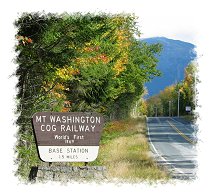
What a difference a day makes. On our first trip up Mt. Washington, via the Auto Road, we arrived at the top of the mountain without much in the way of coats in 32 degree weather and 50+ mph winds. Not wanting to repeat that experience, we came loaded for bear the next day for our trip up the mountainside on the Cog Railroad.
Of course, now that we were equipped for an Artic expedition, it was a nice, balmy day up top, with the temperature in the 50’s. Earlier, however, I heard hikers talking about the 13 degrees and those 50+mph winds they had experienced that morning up top, so we apparently just lucked out for our second assault on the peak.
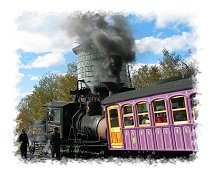
The Mt. Washington Cog Railroad is so improbable that it really has to be seen to be believed. The railroad literally goes straight up the side of a 6000 foot mountain, pushed by tiny little steam engines with slanted boilers. You can’t help but think of the Little Engine that Could when you see these things for the first time…
Mt. Washington was the first cog railroad in the world, and the technology hasn’t changed all that much from when it was first built in the mid-1800’s. The general idea with the cog is the steam engine turns a large gear fitting into slots in a middle track (the cog) to go up, rather than applying power to the wheels like a normal steam engine. To come down, the whole system runs in reverse, with the gear turning the pistons in the engine, acting as a giant brake. The engines puff deep black clouds of smoke going up (they are still coal fired, with the boilers shoveled by hand by firemen). On the way down, cold water is injected into the pistons, and the engines send up pure white smoke. It’s quite the view to be at the bottom and spot several engines way up the slope ascending or descending, depending on the color of the smoke.
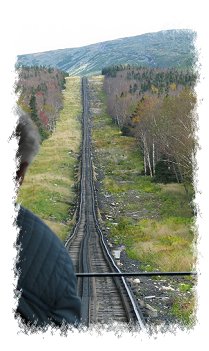
In these days of laser precision measurements, it’s a little unnerving to look up the mountain in front of you and see tracks that wiggle back an forth like a line of spaghetti. Like many of the old narrow gauge railroads, not a lot of effort was (or is) put into keeping the tracks perfectly aligned, as the geared engines can handle a lot of slop in the rails. However, it makes for a wobbly, bouncy ride.
The views are spectacular, but I think the real fun is in the slight thrill of danger. Although the safety record of the railroad is very good, the engine shakes and rattles alarmingly as it strains to push the single passenger car up the hill – seemingly about to fly apart at any moment. It’s hard to stand up in the isle to move about the car, because it’s so steep. The knowledge that some of the steam engines date back to the 1880’s (although highly renovated since then) also gives the whole thing an air of something a tourist might have done before the days of liability insurance and personal waivers. It’s just downright cool.
There is a small connection between the Mt. Washington Cog Railroad and a later stop of ours, which I learned about while browsing in a bookstore in Bar Harbor, Maine. Inspired by the success of the Mt. Washington train, a cog line was built up Green Mountain (today, Mt. Cadillac) outside of Bar Harbor in what today is Acadia National Park. The railroad worked fine, but was a business failure, closing after only 5 years.
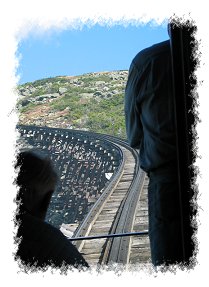
In the mid 1890’s the Mt. Washington Railroad had a catastrophic fire only weeks before the opening of the season, losing some rolling stock and most of their engines. In desperation, the owners learned of 2 engines belonging to the former Green Mtn RR that were just sitting around, so they purchased and installed them on the Mt. Washington line. Amazingly enough, those two engines (#1 and #3) are still in use today, 110 years later.
The steepest place on the line is a trestle (the steepest in the world!) called ‘Jacob’s Ladder’, which reaches an angle of 37 degrees. To put this into perspective, the front of the passenger car is 14 feet higher than the back! It is very difficult to stand up in the car at this point, it is so steep.
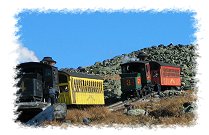
The passenger cars are brightly painted in Victorian colors, and it’s a festive, although unusual view when trains pass each other on the way up or down. In one place there is room on one siding for a couple of trains to pull off, and it’s quite the spectacle when another train comes puffing up the hill next to you. The switches are fairly complex, because not only do the rails need to be switched, but also the slotted cog rail in the middle. Hanging on the side of a mountain, in a train pointed straight up hill, while waiting for a 9 part switch to be thrown is quite the experience.
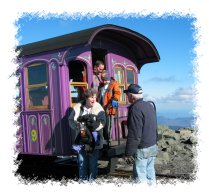
Once we reached the top, after a long, noisy and shaky climb, we spent a few mins taking a picture at the peak (way too cold to do this the previous day). It would have been nice to have had a little more time to visit the weather museum at the peak, but alas, after about 15 mins, the whistle tooted signaling time to load up for the trip down.
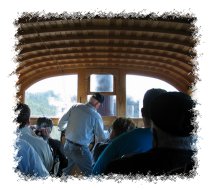
The coach had a brakeman, and while he mainly served as a narrator for the trip going up, he had to work going down. He controlled the speed of travel using a large brake wheel, and he was on it constantly going down. The ride wasn’t quite so rough. Interestingly enough, the seats were flipped over (the backs were now the bottoms and vice versa) so that we were facing downhill on the returned trip.
It’s about a 3 ½ hour trip, and it’s full of sights, information about the different ecosystems going up the mountain, and history about the railroad itself.

Vance: The Cog Railroad is a track up to the top of Mt. Washington. The first train to ever run up was named Hero. Its name was later changed to Peppersass. Peppersass had a crash once because a hiker accidentally flipped the switch. Later it was rebuilt and put on display.
First we got on the train and headed up the mountain. They had to stop once so the train could get some water. The water was used so the engine could have enough steam to make it up the mountain. When we got to the top we got a few pictures at the summit.
RAILWAY TO THE TOP OF NEW HAMSPHIRE!
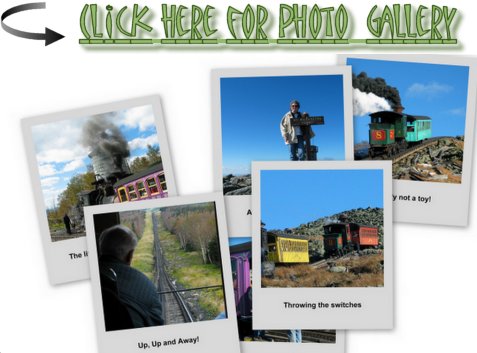







<< Home